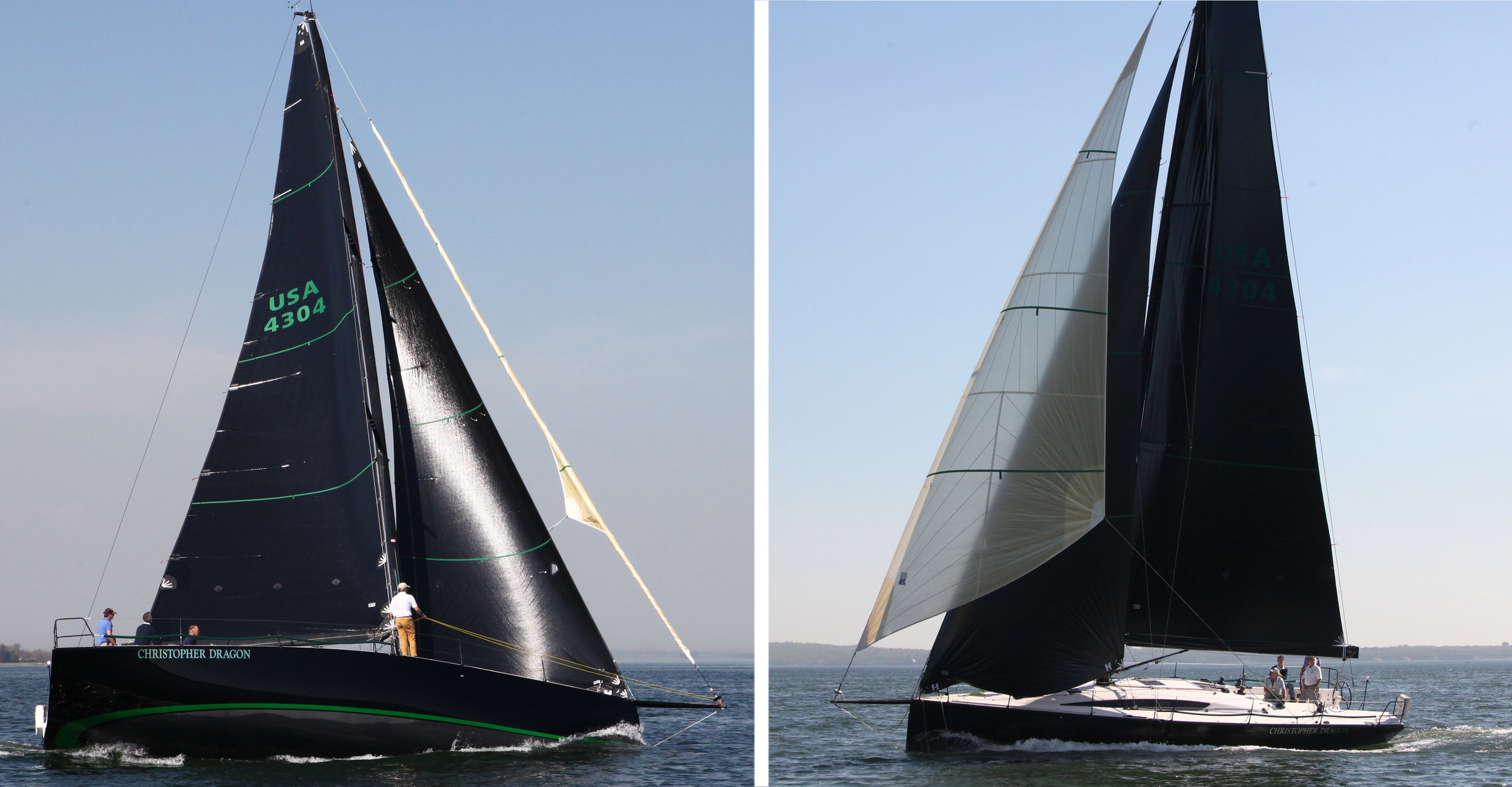The Sydney 43 CHRISTOPHER DRAGON sporting her Flying Jib, double-head rig. Set from the end of the sprit along with a regular jib, the Flying Jib makes the boat significantly faster when close reaching.
For modern race boats with fractional, non-overlapping headsails, jib reaching is a distinct weakness; in conditions too tight for a Code Zero. Boats with overlapping jib topsails have a significant advantage. The Flying Jib is a fix for this problem and even boats using overlapping headsails may benefit from this idea provided they have converted from a spinnaker pole to a sprit.
The Flying Jib derives its name from the clipper ships and in the right conditions it can really make your boat “fly.”
The photos in this article (courtesy Howard McMichael) show a Flying Jib in action on CHRISTOPER DRAGON, a Ker 43 also called a Sydney 43. The sail is set on the sprit using a furling unit and a masthead spinnaker halyard. The increase in performance comes from more than just the addition of sail area. With the sail set out in front of the boat, the center of effort of the boat’s sailplan has moved forward and this almost always makes a boat go faster.
The Flying Jib has a torque rope sewn into its luff so that it can be rolled with a direct line furler
Also, the Flying Jib adds a lot of luff length — the part of a sail that generates the forward force — but very little drag and heeling moment. Note how little of the sail is converging with the center line of the boat in photos below taken from the aft leeward quarter.
While sail testing is still going on, the results have been so positive that we decided to take it public right away.
On the first day it was tested, the winds were light (5-8 knots of true wind). We had set a new jib just to see how it fit and were about to go in when the owner suggested trying this rig. We left the first jib up and set the Flying Jib. We got into a stretch where the TWS was 7 to 7.5 knots and were amazed to be sailing at 8-8.25 knots with an AWA of 43 degrees. We had trouble believing what we were seeing on the instruments and also confirmed with each other that we were too close to consider using a Code Zero.
The Flying Jib is trimmed with spinnaker sheets deflected by twings or tweakers.
We went sail testing again a few days later (when these photos were taken) and we had significantly more wind (14-18 knots). During this testing, we furled and unfurled the Flying Jib a number of times and recorded the speed differential. Each time we unfurled it we added between 0.5 and 0.75 knots boat speed, which we quickly lost once the sail was furled again.
UK Sailmakers’ takeaway from these sail tests is that the Flying Jib is going to be a must-have rig for distance races. On a boat with a retractable sprit, a bobstay will be a must to allow enough halyard tension.
We’re looking at other areas such as the use of this concept on boats with masthead rigs and overlapping headsails. It’s quite likely the triangular shape of the Flying Jib for those boats will change and it may even suggest a change to the shape of the existing reaching jib.
Other factors to consider are halyard stretch, halyard breakage, and sprit deflection. We’ll be sure to keep you posted with regular updates in our newsletters.
All photos by Howard McMichael.


Handicap impact under IRC?
Handicap impact under IRC?
This sail arrangement has no rating impact under IRC provided that the Flying Jib conforms to the HLU, HLP and HSA measurements as published on your IRC certificate.
Butch Ulmer
This sail arrangement has no rating impact under IRC provided that the Flying Jib conforms to the HLU, HLP and HSA measurements as published on your IRC certificate.
Butch Ulmer
Very interesting, it sounds like it could also be an option on a broader reach when wind strength is a little too high for a code zero.
Very interesting, it sounds like it could also be an option on a broader reach when wind strength is a little too high for a code zero.
Nice Concept.
Would this configuration nearly take place of a Zero, with or without a GS? Assuming flying two jibs as mentioned are about the same area of a Fro Zero.
Would be interesting to add a GS to the two jibs as a triple head rig, for boats with slightly longer prodders and J lengths. Would that then negate the Zero?
Just winter talk!
Darren in Aus.
Nice Concept.
Would this configuration nearly take place of a Zero, with or without a GS? Assuming flying two jibs as mentioned are about the same area of a Fro Zero.
Would be interesting to add a GS to the two jibs as a triple head rig, for boats with slightly longer prodders and J lengths. Would that then negate the Zero?
Just winter talk!
Darren in Aus.
numbers don’t match
TWS was 7 to 7.5
sailing at 8-8.25
AWA of 43 degrees
too close to consider using a Code Zero. Or is UK’s Zeros total downwind sails?
numbers don’t match
TWS was 7 to 7.5
sailing at 8-8.25
AWA of 43 degrees
too close to consider using a Code Zero. Or is UK’s Zeros total downwind sails?
Under ORR there would be a rating charge for this configuration because you would need to report a "J" measurement that reflects a tack point at the end of the prod.
Under ORR there would be a rating charge for this configuration because you would need to report a "J" measurement that reflects a tack point at the end of the prod.
How heavy is the cloth? j1/j2?
How heavy is the cloth? j1/j2?